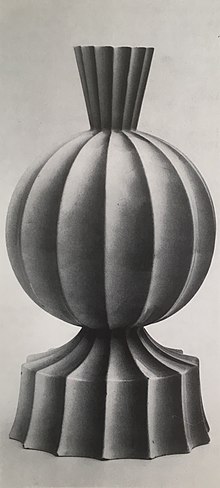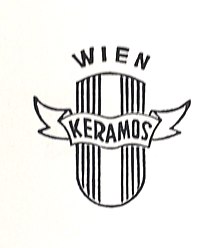Keramos Vienna
| Keramos AG, Keramos KG
|
|
|---|---|
| legal form | |
| founding | 1919 |
| resolution | 1982 |
| Seat | Vienna , Austria |
| management | Otto Köller (AG, 1924–41), Robert Mathis (KG, 1945- ~ 1970), Klaus Mathis (~ 1970–1982) |
| Branch | Arts , crafts |
The Keramos , later Keramos AG or Keramos KG , was a Viennese ceramics factory, mainly engaged in the inter-war period has made a name. In addition to its own designs, from 1932 designs by the dissolved Wiener Werkstätte were also produced. In over 60 years of company history, around 3000 model designs have been produced by around 60 ceramists.
history
The origins of the Keramos company lie in two companies with the same name. The company Keramos - Disability Society of Viennese art ceramic was the end of 1919 at the initiative of the three ceramists Rudolf Wolf, Heinrich Wolf and Ludwig Rys that in World War I to disability founded had become. Production could begin in September 1920. Ceramic art lamps, figures, vases and boxes were produced.
The company Keramos - Wiener Kunstkeramik und Porzellanmanufaktur was founded in 1920. Josef Hoffmann was a partner in Keramos for a long time , as was the sculptor Rudolf Podany, who was committed from the beginning and who created a large number of designs. From 1921 Anton Klieber was employed, who was also responsible for a large number of the models.
Around 1924 the two companies were merged and converted into an AG, Otto Köller became the commercial director and the brothers Rudolf and Heinrich Wolf became the technical directors.
"Some war-disabled ceramists founded a workshop with the help of some artists, which was subsequently financed by the state and later enlarged with its participation and converted into a stock corporation."
The company was based in the Hofburg , Schwarze-Adler-Stiege, and the factory in Vienna's 10th district, Schleiergasse 17.Artistic employees at this time were Eduard Klablena , Otto Prutscher , Karl Perl , Karin Jarl-Sakellarios , Ida Schwetz- Lehmann and Grete Fucik-Fischmeister. On February 23, 1928, the triangular mark was entered in the trademark register. Production was now also carried out for the Wiener Werkstätte.
Difficulties for the company arose from the Great Depression . Around 1932 50 people were employed and a large number of models were taken over from Eduard Klabena and the dissolved Wiener Werkstätte. The works that have now been created at Keramos were labeled with their company brands until after 1941. From 1939 onwards, the company's economic situation was regained better control by taking over the production of ceramic winter relief badges, the so-called WHW badges.
The company is a limited partnership called before 1941 Keramos, Vienna Art Pottery and Porcelain Factory brothers Wolf KG converted . Otto Köller was no longer active from this point in time.
After the end of World War II , Robert Obsieger recommended Robert Mathis as the new head of Keramos, who took over the management of the ceramic factory in 1945. In 1949 Mathis introduced a new company logo that was used alongside the existing triangular mark, the so-called coat of arms mark.
Anton Klieber and Rudolf Podany continued to work as ceramists, and new artists such as Josef Lorenzl and Stephan Dakon , who had both previously worked for Goldscheider , as well as Rudolf Chocholka, Karl Grössl and Ina Eisenbeisser were hired. New models were created such as dancers, children's figures, animals and nudes, and from the mid-1950s onwards also the well-known wall masks, young people and poodles, which corresponded to the trend at the time. In addition, however, traditional designs such as statues and busts of the Madonna, saints and angels were still made.
Utility ceramics such as tableware, vases, lamp bases, candle holders and flower pots also became an important branch of production, and a collaboration with the German manufacturer Carstens at the beginning of the 1960s was just as lucrative.
In the course of the 1960s, the sales markets for figural ceramics became increasingly difficult. So production was increasingly shifted to utility ceramics until 1982, as ceramic figures were no longer modern due to the changing taste and zeitgeist. Ultimately, the economic situation at Keramos became more and more difficult and Klaus Mathis, the son of Robert Mathis and then director, who had succeeded his father at the top of the company at the beginning of the 1970s, initiated the liquidation of the company at the end of 1982 .
Employee
The following artistic collaborators have worked for Keramos over the years: Hans Adametz , Franz Barwig the Elder , Franz Barwig the Younger , Andreas Beck, Hans Bolek, Angelo Bortolotti, Hertha Bucher , Rudolf Chocholka, Stephan Dakon , Ferdinand Doblinger, Eckstein, Franz Eggenberger , Ina Eisenbeisser, Englich, Stephan Erdös, Alois Feichtinger, Feyslitz, Hans Friedberger, Grete Fucik-Fischmeister, Kurt Goebel, Anton Grath , Karl Grössl, M. Günther, Otto Hafenrichter, Arnold Hartig , Friedrich Herkner, Trude Hillinger, Leopold Hohl, Hostasch, Karl Jamök, Karin Jarl-Sakellarios , Eduard Klablena , Klar, Anton Klieber, Maria Klinger, Josef Kostial, Josef Lorenzl , Wilhelm Otto Lugerth, Viktor Matula, Gusty Mundt-Amman, Novotny, Carl Perl, Rudolf Podany, Friedrich Pollak, Hugo Postl, Adolf Prischl, Otto Prutscher , Max Rieder , Elisabeth Rieger-Hofmann, Walter Ritter , Willibald Russ, Karl Sailer, Schönberg, Schwarz, Ida Schwetz-Lehmann , Sult, Robert Ullmann , Otto Weigand, Ida Weiss- Moricz, Rudolf Wolf.
Exhibitions
- Anniversary exhibition of the Vienna Arts and Crafts Association, Austrian Museum , Vienna 1924.
- Applied Arts Exhibition Paris, 1925.
- Exhibition of Austrian applied arts, Essen 1927.
- Christmas show in the Vienna Künstlerhaus , 1929/30.
- Werkbund exhibition in the Austrian Museum, Vienna 1930.
- Exhibition The Modern Apartment in the Austrian Museum, Vienna 1930/31.
- Exhibition Flower and Sculpture , Wiener Künstlerhaus, 1931.
- Exhibition 50 Years of the Vienna Arts and Crafts Association in the Austrian Museum, Vienna 1934.
- Exhibition of the New Werkbund Austria in the Austrian Museum, Vienna 1935/36.
Awards
- Silver medal (Paris Arts and Crafts Exhibition, 1925)
literature
- Waltraud Neuwirth: Viennese ceramics: Historicism, Art Nouveau, Art Déco . Klinkhardt & Biermann, Braunschweig 1974, ISBN 3-7814-0163-4 .






